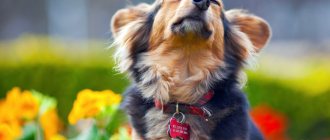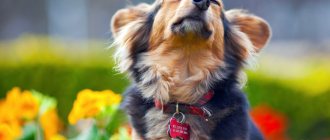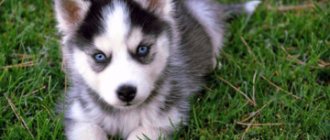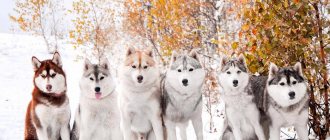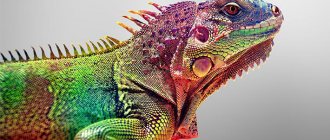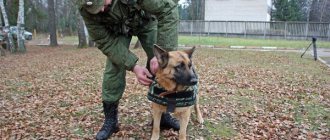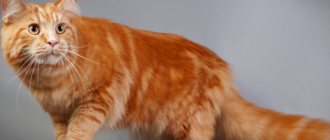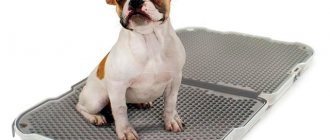The piercing gaze of blue eyes and the wolf color of the coat have turned the husky into a sought-after show dog and a wonderful companion. But when keeping in an apartment, it is necessary to take into account the characteristics of the breed - high activity, intolerance to high temperatures and loneliness.
The owner will have to devote a lot of time to games and walks with the pet so that he does not turn everything upside down. Only by taking into account the advice of dog handlers can you provide the animal with proper care and raise a healthy, obedient friend.
Is it suitable for living in an apartment?
Although huskies are large dogs , their size makes it quite possible to keep them in city apartments, but only on condition of regular active walks and providing the necessary level of physical activity .
If possible, it is better to install a cage or a small enclosure in the apartment where you can lock your pet while the owners are away. This will help avoid damage to furniture and other property, which can happen if the husky gets bored alone.
Even if you have a cage or enclosure, you should not leave your dog alone for a long time..
Representatives of this breed tolerate frost well, but do not like heat. Therefore, in summer it is better to walk them either early in the morning or in the evening.
If you can only take your dog outside during the day, you should choose a shaded place for a walk.
These dogs can withstand the sun for a maximum of 1 hour; longer exposure to the sun can lead to severe overheating..
It is also important to ensure that your pet has constant access to clean, drinking, cool water.
Advantages and disadvantages
Husky adapts quite quickly to living in a limited area. But keeping such large dogs in a city apartment still has not only advantages, but also a number of disadvantages.
The main advantages of this type of content include:
- constant contact between owner and dog;
- continuous involvement of the pet in the life of the owner and his family, which has a positive effect on the mental health of huskies who need communication;
- An energetic and cheerful four-legged friend nearby will not let you get bored or feel lonely.
In addition, the inherent cleanliness of representatives of this breed will be even more developed, the pet will grow up patient, since he will need to wait until the owner takes him for a walk.
Disadvantages of keeping a husky in an apartment:
- the need for even more strict education, which does not allow any mistakes, so that the dog learns to behave carefully and with restraint;
- heavy molting, occurring twice a year;
- in case of lack of attention and insufficient amount of physical activity, the pet may, out of boredom, damage the owner’s furniture, shoes and other property.
Also, do not forget about the tendency of these dogs to howl for a long time, which can lead to complaints from neighbors.
Sports equipment: sled, sled, sledge, harness
Features of a riding harness for a husky: the design of such a harness should not restrict the dog’s movements or cause discomfort, otherwise it simply will not be able to carry you .
Such a harness should be well fixed and distribute the weight of the load evenly throughout the body. The straps should be wide and the fastenings strong. Sleds for sledding are sold in specialized stores, and it is still advisable to purchase them there so as not to harm the animal. They are about 80 centimeters wide, and the length directly depends on the number of dogs in the sled. The main rule when choosing a sled is its stability and reliability. Protect both yourself and your dogs.
The sledges themselves are a slightly simplified version of the sleigh, since they are created only for transporting a person, without load. They are much lighter than a sled and will be much easier for the dog to pull. You can often find lightweight aluminum sleds, which due to their design will make traction even easier. However, the choice is yours - wooden sleds are still more reliable.
The harness for your dogs should also be of good quality in order to evenly distribute the load between all parts of the harness. The fastenings that secure each dog in its place must be very strong so as not to accidentally lose a single animal or knock the sleigh or sled off course. Therefore, before choosing riding equipment, consult with those who are already actively using this sport.
Relationships with household members
How does a husky get along with children? Wonderful! This dog is just for those who are not afraid to leave them alone with children. She will happily play with the kids and will not bite. Therefore, this breed is an excellent choice for families.
In turn, a dog will get along with cats if it grew up with them. Otherwise, the cat runs the risk of becoming for the dog an object of irrepressible curiosity and games that the cat itself is unlikely to like.
A newborn child, as in the case of older children, will not be offended by a dog. This is not an aggressive breed at all, so don’t worry if you are planning to have a baby in the family - your pet will not harm him.
Is it suitable for outdoor use?
Street keeping is the most suitable option for representatives of this breed..
The husky's coat allows them to easily withstand even severe frosts, so these dogs can live outside throughout the year.
The territory in which the dog lives should be fenced with a high fence, since the husky will easily jump over a small fence in an effort to break free.
Advantages and disadvantages
The advantages of street maintenance include:
- strong immunity and thick, shiny coat, due to the dog’s constant exposure to the fresh air;
- the dog has the opportunity to play at any time;
- Huskies get the freedom of movement they need so much;
- there is no need to accustom your pet to the tray;
- Walks outside the yard may be shorter.
Disadvantages of such content:
- dogs in need of communication have less contact with their owner;
- it is necessary to carefully fence the area so that the pet cannot jump over the fence or dig under the ground and escape;
- building a spacious enclosure and kennel that a dog needs requires financial costs.
In addition, we must not forget that even if kept on the street, huskies will not become guard dogs.
Siberian Husky breed standard
Today, huskies are divided into three groups - sledding, sporting (racing) and exhibition.
The official breed standard describes a sled dog. To a greater extent, British-bred huskies fall under these criteria.
Dimensions
Siberian Huskies in their element
The Siberian Husky is a medium-sized animal. The height of a dog at the withers is from 54 to 60 cm, of a female – from 51 to 56 cm. The weight of dogs is 21-28 kg and 16-23 kg, respectively. Excessive height is grounds for disqualification. The husky's weight is proportional to his height, the length of the body when viewed from the side is slightly greater than the height at the withers (extension index 110-120).
Head
The skull is small in size, rounded at the back of the head and tapering evenly towards the eyes. The bridge of the nose is smooth, the stop is clearly defined. The muzzle is of medium length, with almost the same distance from the nose to the stop and from it to the back of the head. It tapers evenly to the nose, which should be neither sharp nor square.
Huskies are characterized by a lively and interested, even with a certain amount of mischief, expression on their muzzle.
The disadvantages include:
- a sharply defined and massive head;
- the presence of an unclear transition from the muzzle to the forehead;
- black nose for gray, red and black huskies, and brown for brown dogs;
- muzzle too narrow or too wide.
Eyes
Set slightly obliquely at an average distance from each other, almond-shaped. The color of the iris is brown or blue, mosaic-colored or heterochromic options are allowed.
Disadvantages: eyes that are too close and too slanted.
Husky eyes
Ears
Husky ears are located high on the head at a short distance from each other. They stand firmly, with slightly rounded tips pointing straight up. The ears are medium-sized and triangular in shape.
Disadvantages – the ears are too large (in relation to the size of the head), the tips are directed not upward, but to the sides.
Teeth
A scissor bite is required; any deviation is a fault.
Neck
Husky muzzle
Medium length, raised on a standing animal. When moving, it bends so that the husky's head is slightly forward.
Disadvantages - too thick, as well as excessively long or short neck.
Frame
The chest is strong and deep (huskies have a fairly large heart), the ribs are widely spaced. The back is strong, with a level line from the shoulder blades to the croup. The lumbar region is elastic and tucked.
Disadvantages - too wide chest with barrel-shaped ribs, sagging back, sloping topline from the shoulder blades to the croup.
Tail
In a calm state, the husky's tail is slightly lowered and is located slightly below the line of the back. When the dog is interested or excited, it bends upward in a sickle shape, but curls into a ring, does not roll over its back or curl to the side. The coat has approximately the same length, which is why the husky's tail resembles a round fox's.
Disadvantages - too low or, on the contrary, too high, tightly curled tail.
Limbs
Brown Husky
The front ones are straight and parallel, located at a moderate distance from each other. The elbows are pressed to the body, turning neither in nor out. The bone is not heavy, but strong.
The hindquarters are parallel, moderately spaced. The knee joints are mobile, hock, have clearly defined angles and are located close to the ground.
Vestigial digits on both the front and hind legs must be removed.
Disadvantages: cow-like hindquarters, elbows turned outward, heavy large bone.
Paws
Husky paws are medium in size, oval, but not elongated. Well furred between the pads of the toes. The pads are thick-skinned. When the dog is at rest, its paws do not turn to the sides.
Disadvantages: clumsy or, conversely, too small paws, flat toes.
Wool
The husky's coat is of medium length, which, creating the effect of good furring, does not interfere with viewing the lines of the body. The undercoat is soft and dense. The outer coats are straight and smooth, but in no case coarse or erect.
Disadvantages: shaggy, hard coat.
Color ranges from pure white to black. There are white mask-like markings on the head, characteristic only of huskies.
Photos of adult huskies
Basic rules of care
Huskies are unpretentious dogs.
They do not require complex care and all manipulations necessary to maintain the external attractiveness and health of the pet are reduced to a set of hygiene procedures, including:
- the washing up;
- combing;
- trimming nails;
- cleaning teeth and ears;
- rubbing the eyes.
The dog must also be vaccinated according to schedule and treated against fleas, ticks and helminths.
Expert opinion
Kozhevin Semyon Kirillovich
Expert dog handler.
The main thing that representatives of this breed need is regular active walks. Unable to get rid of the energy accumulated during the day, huskies suffer both psychologically and physically. It must be remembered that these are active dogs bred to work, so they need physical activity. Also, hygiene procedures, vaccination and treatment against parasites should not be neglected.
Tolerance to frost and heat
These northern dogs love winter. Huskies really blossom with the arrival of cold weather. Snow is their native element, and their thick undercoat allows them to easily endure cold temperatures down to −30 °C.
Winter is a dog's favorite season
When it's hot, things are more complicated. Although the air cushion of the wool protects them from overheating, in the heat it is better to postpone long walks and active games.
Important! A husky should never be cut to keep it cooler. The air cushion of the fur protects them from the heat, which is enough for the dog.
If your dog can't handle the heat very well, a special cooling blanket can help. You can buy it at a pet store or order it online.
Where is the dog's private place in the house?
The pet needs to have a place where it can sleep or just relax. In the case of a husky, it is better to choose a cool place, for example, a spacious corner in the hallway with a tiled floor.
CAREFULLY!
But the dog should not sleep on the bare floor - prolonged lying on a hard surface can lead to the formation of bedsores.
The best option is a wooden platform at a height of 20-30 cm from the floor, a special mattress or bed.
The sleeping place must match the size of the dog so that it feels comfortable when stretched out to its full height.
What temperature can Huskies withstand?
Huskies and other northern sled dogs feel better outside in cold winters than in hot summers: they do not freeze at sub-zero temperatures - they are protected by a warm two-layer fur coat. -20–30 °C is not a problem for them, and huskies can be kept outside if you are ready to equip a warm kennel and create a comfortable life for the dog.
How to feed
The basic rule of feeding a husky that must be followed is that the diet must be balanced, based either on natural products or on industrial food, since mixed nutrition is unacceptable.
With a natural diet, the pet must be given:
- lean meat;
- offal;
- sea fish;
- eggs;
- dairy products;
- animal and vegetable fats;
- vegetables, fruits, herbs;
- cereals;
- "sugar" bones.
As an additional source of calcium, you should include a small amount of eggshells in your dog's menu.
Banned for Huskies:
- confectionery, sweets, chocolate;
- grapes and raisins;
- pork, lamb;
- pickles, smoked meats;
- citrus;
- potato;
- milk;
- spicy, salty food;
- tubular bones;
- River fish;
- bread and baked goods;
- pasta;
- legumes;
- salo;
- nuts.
The diet of an adult dog must contain at least 70% meat or meat products.
In cases where feeding is based on industrial feeds, you should buy products of at least premium class.
The most popular foods suitable for representatives of this breed are Nutra Gold, Advance, Purina Pro Plan (Sensitive Salmon, Medium Robust Health, Medium Robust, Medium Puppy Sensitive), Royal Canin, Happy Dog (Maxi Baby and Nature Croq).
Meat
The digestion of northern sled dogs is designed to absorb proteins and fats and practically does not break down carbohydrates. The basis of feeding a husky is meat. Three times a week it is replaced with offal and sea fish.
The share of meat in a husky’s diet is no less than 65–75% or 20–30 g per kilogram of the animal’s weight.
The table lists what kind of meat a Husky can eat:
| Meat | By-products | Fish |
| beef veal chicken turkey horse meat rabbit game pork without fat | scar liver lung kidneys tongue heart kaltyk trachea | cod hake pollock mackerel salmon tuna sea bass halibut |
A dog's digestive system is designed to process chunks of food. Therefore, the meat is not ground or turned into minced meat. The meat is given raw. After heat treatment, beneficial substances are destroyed. To destroy harmful bacteria, pre-freeze for 5 - 7 days.
The share of cereals in a husky’s diet does not exceed 5–10%.
Huskies do not digest porridge and pasta. The rest of the diet is distributed among vegetables, fruits, and dairy products.
To gain weight, buckwheat, rice, and rolled oats are sometimes added. If you overfeed a dog with cereals, problems with the skin and fur begin, the eyes become watery, and the overall tone decreases.
How often should you go for walks? How long should you walk?
You can start walking your dog no earlier than the end of the quarantine period after vaccination, i.e. at about 3 months.
Puppies be taken outside 15 minutes after feeding, approximately 5-6 times a day .
Adult representatives of the breed can be walked twice a day. The longer the walks last, the better, but if time is limited, the duration of the walk should be 1-1.5 hours, while the morning walk may be shorter than the evening walk.
Walks should be active and include:
- running without a leash in specialized fenced areas;
- communication with other animals;
- elements of training.
After intensive walks and physical exercises, the dog will sleep soundly and will not have the strength to misbehave in the house.
How long does this breed sleep?
Huskies, like all dogs, sleep on average 12-14 hours a day. The place to sleep should be soft, without drafts, in a quiet corner. This could be a large bedding pillow or a house.
It is best to arrange a place to sleep in a secluded corner of the apartment.
It is not advisable for Huskies to sleep on the same bed with a person, since this breed is not deprived of leadership leaps. A husky sleeping next to its owner will constantly compete for the title of leader.
How to toilet train a puppy? How to stop shitting in your apartment?
You need to place as many newspapers or diapers in the house as possible, especially near doors, windows and in places where the puppy craps most often.
Over time, the number of diapers needs to be reduced until one remains, which needs to be gradually moved to a place that the owner has designated as the pet's toilet . When the husky remembers the place of the toilet, the diaper should be replaced with a tray.
You should not physically punish your puppy for urinating in the wrong place. It will be enough to verbally show dissatisfaction.
When your baby is allowed to go for walks, you will need to take him outside after each feeding and not return home until he goes to the toilet..
Plant food
Vegetables, fruits and berries are needed as a source of fiber, vitamins, microelements, to cleanse the intestines and form stool. The table contains a list of vegetables that can be given to huskies without fear:
| Vegetables | Fruits and berries |
| carrots zucchini pumpkin cauliflower white cabbage broccoli bell pepper green beans turnip cucumber eggplant sometimes | apple pear banana blueberries strawberry watermelon pulp gooseberries raspberries currants melon |
Vegetables are added to the meat raw, chopped on a grater. Fruits and berries are offered as treats if the dog likes them.
How to trim claws correctly and when?
Huskies that live outside spend many hours a day “on their paws,” so their nails wear down on their own. The same thing happens with dogs kept in apartments that often walk outside for a long time.
In all other cases, the pet's claws need to be trimmed so that they are not too long.
IMPORTANT!
If this is not done, the claws begin to prevent the dog from walking and placing its paws correctly, which leads to pain, lameness and improper distribution of the load on the tendons and joints.
The procedure needs to be carried out on average once every 3-4 weeks, more often in winter, since even with regular walks the claws do not touch hard ground.
For trimming you will need a quality nail clipper . You should not skimp on it, since a bad tool breaks and crumbles the claws, which causes them to separate and crack.
You need to cut the claws at the angle of their natural growth, removing literally a few millimeters at a time, so as not to touch the blood vessels.
The sharp edge should be filed with a file to avoid delamination of the claw.
Before trimming, you can soak the dog’s paws in warm water - the nails will become softer and the procedure will be faster and easier.
Paws
The claws are trimmed with a nail clipper when they grow to the floor and begin to clatter. The frequency of procedures is determined by yourself. City dogs have their claws partially worn down on the asphalt. If the dog only walks on the ground and grass, they grow back faster and are pruned more often.
Husky claws are cut at an angle, as in the first picture.
The fur between the toes is carefully trimmed. In summer, dirt accumulates between the pads; in winter, ice balls stick and interfere with running. Trimmed paws are easier to wash after walks.
In spring, summer and autumn you need to choose a remedy for ixodid ticks: drops, collar or tablets.
How to properly clean your ears
Huskies have erect ears, so there are much fewer problems with them than breeds with floppy ears . However, it is necessary to monitor their health and clean them regularly.
If your pet's ears become inflamed, make a squelching sound, or smell unpleasant, you should contact your veterinarian.
You need to clean your dog's ears on average once every 2-3 weeks, for this you need:
- lay the pet on its side;
- drop a special lotion into his ear;
- massage the auricle for 1-2 minutes, stimulating the softening of earwax and dirt;
- Wipe your ear with a cotton pad soaked in boiled water or the same lotion, removing wax and dirt.
You should not use cotton swabs to clean your ears, as this can push dirt and wax deeper into the ear.
Hygiene
Caring for a puppy and an adult husky is quite simple - a minimum of hygiene procedures is required.
Care is based on general recommendations for keeping pets: periodic bathing, combing, cleaning ears and teeth. The only period that causes inconvenience in the apartment is molting.
Bathing puppies and adult dogs
You should not bathe a puppy or an adult husky unless necessary, because when kept in an apartment, pets do not get dirty so often. They are able to take care of their fur coat themselves, and their fur is capable of self-cleaning. Hygienic care is needed only after a walk - washing the paws and wiping the fur with a damp towel.
The minimum age at which bathing will not cause harm is 3 months. By this time, the puppy has developed a fairly strong immune system.
After washing, the pet is dried with a towel and left in the apartment until completely dry. If he is not afraid of noise, it is advisable to use a hairdryer so that no moisture remains in the undercoat.
For your information. In winter, huskies bathe on their own, lying around in the snow - they do not need additional care.
Wool
Caring for Husky fur in an apartment consists of combing at least 2 times a week with a wide-tooth comb or a furminator, which removes dead undercoat without damaging living hairs.
Huskies shed profusely, which causes a lot of trouble when kept in an apartment. During the molting period, animals are combed daily.
In areas where the change of seasons is weakly expressed, the process usually goes unnoticed, since the pet does not grow a thick undercoat.
Important. Some dog breeders are too lazy to care for huskies and cut their fur. This cannot be done - natural heat exchange is disrupted, which is why the dog can become hypothermic or overheated.
Eyes
Eye care is reduced to wiping once a week with a solution of chlorhexidine or chamomile decoction. After field trips, they are inspected for dust and damage.
If redness or excessive tearing occurs, the husky is immediately taken to the veterinarian - a specialist will tell you what kind of care they need.
For your information. The breed is prone to ophthalmic diseases. If you take proper care of your eyes, the risk will be minimized.
Teeth
Huskies that eat dry food clean their teeth of plaque when they chew hard kibble.
With a natural diet, the owner must care for them independently using veterinary paste and a toothbrush. The procedure is carried out 1-2 times a week.
On a note. To prevent tartar, huskies are periodically given brain bones or dental treats to chew on.
Ears
The owner should take regular care of the ears - inspect them approximately once a week. If sulfur and dust have accumulated, wipe them with a cotton pad soaked in a solution of hydrogen peroxide or chlorhexidine.
The onset of the inflammatory process is indicated by itching and frequent shaking of the head. In this case, the husky is taken to the veterinarian - the doctor will prescribe special drops for caring for the ears.
Claws
Active huskies usually wear down their claws by running on asphalt and other hard surfaces, so they do not require additional care. If the dog moves only on the ground and soft floor in the apartment, the claws are shortened once a month using a nail clipper.
For your information. For hygienic purposes, the hair between the paw pads is also trimmed to avoid dirt accumulation. It provides protection from frost, but when kept in an apartment, the pet is not exposed to the cold for many hours in a row.
Grooming. What is husky fur an indicator of?
Representatives of this breed cannot be cut or trimmed; the husky's coat only needs to be combed every 2-3 days with a slicker or brush, and during seasonal shedding daily with a comb, comb and furminator.
First, the coat must be moistened with water, then combed along the hair growth from head to tail, and then in the opposite direction. When all the wool has been combed against the hair growth, you need to lightly brush it while styling it. At the very end, you should comb the tail.
Regular brushing eliminates the possibility of matting and tangles.
With proper coat care, females shed 2 times a year, males - 1 time every 1.5 years.
Husky fur has a unique structure, thanks to which these dogs not only tolerate frosts down to -60 ° C without problems, but are also able to warm people with their warmth, something that Eskimos often used in the past.
According to scientists from the University of Alaska, the husky's coat can help detect mercury pollution in the environment, being an indicator of the presence of mercury..
Dairy products
Fermented milk products are given as a separate feeding instead of meat. They improve the composition of the gastrointestinal microflora and enrich the diet with calcium.
Huskies can be given fermented milk products without sugar except sour cream:
- cottage cheese up to 5% fat;
- kefir;
- curdled milk;
- fermented baked milk;
- yogurt without additives.
To enrich the food with vitamins and microelements, it is useful to add to the main dishes:
- raw chicken, quail egg – 3 times a week;
- sunflower, flaxseed oil – 1 teaspoon per serving of food;
- bran;
- greenery.
Always leave a bowl of clean water freely available. The dog will decide for himself how much and when to drink.
How to bathe correctly and how often it should be done
The husky's coat is capable of self-cleaning, so representatives of this breed do not need frequent washing. The only thing you need to do regularly is wash the paws and belly of a dog living in an apartment after every walk.
You need to thoroughly wash your pet no more than once a quarter, using shampoo that matches the type and color of the coat .
First, you should thoroughly wet the topcoat and undercoat, then apply shampoo, lather it and rinse thoroughly with water, making sure that it does not get into the pet’s ears and eyes.
Before bathing your puppy for the first time, you need to lay a rubber mat on the bottom of the bathtub so that the dog’s paws do not slip..
After bathing, the dog should be dried with a terry towel and thoroughly dried with a hairdryer so that the undercoat does not remain wet.
Walking and physical activity
A mandatory component of caring for and maintaining a sled dog at home is daily active walking. A husky is always kept on a leash when outdoors, as it may suddenly chase a cat, pigeon or fellow dog.
Exercise also includes outdoor games - tug-of-war, give-and-fetch, and overcoming obstacles.
Walking with a husky goes well with jogging and cycling. In winter, your pet can be harnessed or skied while walking. Full loads are allowed only after a year - before this time the dog’s skeleton is formed, so he is prohibited from:
- run up steep stairs;
- jump high;
- overcome long distances.
When keeping a husky in an apartment, you need to walk at least 2 hours a day. This time can be divided into equal parts - an hour in the morning, an hour in the evening. If the owner is in a hurry to go to work, then in the first half of the day he is allowed to limit himself to a 30-minute jog, and in the evening he can have a full exercise.
On noisy city streets, a pet will not be able to properly frolic, so it is most convenient to walk a husky in parks, squares and other green areas where there are no large crowds of people. An excellent leisure option for a dog living in an apartment would be a trip to nature or a hike.
On a note. In Moscow, dogs can be walked without a leash or muzzle in special fenced areas. Otherwise, the owner faces a fine.
How to brush your teeth?
There is an opinion that since huskies have good health, there is no need to take care of the teeth and the general condition of the oral cavity of these dogs. This is wrong. The quality of primary food processing and its preparation for digestion depends on the condition and health of the teeth.
Poorly chewed food can lead to serious problems associated with your pet's gastrointestinal tract..
Diseased teeth provoke the formation and development of bacteria and toxins, which can get not only into the dog’s nose and ears, but even into the heart and lungs, and cause the development of inflammatory processes.
This is an indication that your husky has dental problems.:
- unpleasant odor from the mouth;
- redness of the gums;
- swelling of the muzzle:
- the appearance of blood or pus in saliva;
- noticeable damage to teeth;
- exposure of tooth roots.
To avoid such problems, it is necessary to take care of your pet’s teeth from puppyhood, preventing the appearance of plaque, which can lead to periodontal disease.
It is necessary to brush your pet's teeth daily using a special brush and toothpaste designed for dogs . It is important to ensure that the movements of the brush are not directed across the axis of the tooth.
You also need to regularly give your dog bones, tendons and other chewable objects - they help mechanically clean the teeth, which prevents the formation of plaque and tartar.
What should be the conditions
By purchasing a clean husky, owners take on great responsibility and must understand how to keep the animal properly at home. The daily diet of a purebred dog includes many microelements necessary for growth and development. They are found both in dry food and in natural products. The advantage of dry food is that the amount of necessary vitamins is already calculated for the daily requirement. If you feed natural products, it is difficult to guess whether a husky can get enough nutrients.
Related article: Do Husky dogs bark?
A husky living in a private house runs the risk of eating too much. On the one hand, this is normal, because in nature dogs eat not only selected meat. But on the other hand, a pet that is accustomed to a certain diet is susceptible to frequent disorders if unusual foods and things enter the body.
Features and conditions of living on the street
Caring for a street dog is practically no different from caring for a pet living in an apartment. He also needs to be bathed, combed, teeth and ears cleaned, regularly treated for external parasites and dewormed.
It is necessary to build a spacious enclosure for the husky, which will not limit the freedom of the animal . It needs to be carefully strengthened around the perimeter, and a durable covering of wooden boards or tiles should be laid on the ground.
NOTE!
It is important to keep the enclosure clean and ensure that the dog does not drag foreign objects into it that could injure him.
You also need to make sure that the dog has enough toys and constant access to water.
In winter, you should insulate the booth with blankets or rugs, and in summer, on the contrary, lighten it . Also, in the summer, it is necessary to equip a canopy in the yard so that the pet can hide under it from the scorching sun.
Rules for raising and training huskies
The peculiarity of the Husky breed is their freedom-loving character. These are echoes of the historical past. Previously, dogs were used only in winter and released in summer. Hence, dogs of this breed have a tendency to run away and willfulness. This must be taken into account when drawing up a program for raising and training pets.
It is best to send huskies to a “dog and nursery” or “dog school” from puppyhood. There, professional dog trainers will teach your pets basic obedience skills and a basic set of commands. It is also important to socialize your dog early so that you can safely walk him in crowded places and on pet-walking areas.
In order for the care and education of a husky to produce good results, you must strictly adhere to the following rules:
- Huskies are sled pack dogs. They need a clear leader to follow. The owner must become such a leader. One effective way to do this is to make your husky wait for food. The leader (master) eats first!
- The dog must understand that the owner is the only source that gives it food.
- When walking, do not allow your dog to walk in front of you. It is especially important to stay ahead of your pet when walking through narrow passages.
- Strictly prevent the dog from trying to take the lead.
- It is unacceptable to establish leadership through physical punishment, restraint of freedom (cage), pain and bullying. If you cannot achieve compliance with a certain rule using verbal commands, you can take the dog by the withers and press it to the ground.
- Compliance with the rules is rewarded with treats and praise.
- The dog must know which rooms of the house it has access to. The time for walking and feeding is strictly defined - this disciplines the husky.
It might be interesting to read about husky mixes.
Can you keep it on a chain?
Huskies are active, cheerful dogs that need to be in constant contact with other animals and people; they need freedom..
In addition, representatives of this breed lack protective and watchdog instincts, and attempts to develop them and turn good-natured huskies into watchdogs negatively affect their psyche.
Huskies cannot be kept on a chain . On a leash, dogs do not have the opportunity to move freely, communicate and take part in the life of the family.
Such restrictions negatively affect not only the animal’s mental state, but also its overall health. Constantly keeping a dog on a chain dooms a dog to a life of depression and suffering.
At the same time, you should remember the characteristics of the husky , which consist in the desire to dig holes and jump over the fence in order to walk freely .
Therefore, for the safety of the pet, it can be tied up while the owners are away from home. But even in this case, the chain must be long enough - at least 4-6 m.
What do huskies get sick of?
Dogs of this breed have fairly good health; they live on average from 11 to 13 years. Siberian Husky diseases that are typical for huskies include progressive retinal atrophy, hypothyroidism, cataracts and corneal dystrophy.
Constantly monitor your pet's health and seek advice from a veterinary clinic. Among the symptoms that should alert you: lethargy and apathy, lack of appetite, nausea and digestive problems, lameness, eye decay, bruises, open wounds and more. Don't forget that a timely visit to the doctor can save your pet's life.
Help the pet
